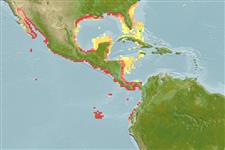Teleostei (teleosts) >
Eupercaria/misc (Various families in series Eupercaria) >
Lutjanidae (Snappers) > Lutjaninae
Etymology: Lutjanus: Malay, ikan lutjan, name of a fish.
More on author: Valenciennes.
Environment: milieu / climate zone / depth range / distribution range
Ecology
Marine; reef-associated; depth range 0 - 60 m (Ref. 131014), usually 9 - 15 m (Ref. 5227). Tropical; 33°N - 3°S, 116°W - 77°W (Ref. 55)
Eastern Pacific: Mexico to Ecuador. Most common at offshore islands including Mapelo, Galapagos, Tres Marias and Revillagigedo.
Size / Weight / Age
Maturity: Lm ? range ? - ? cm
Max length : 30.0 cm TL male/unsexed; (Ref. 55)
Dorsal spines (total): 10; Dorsal soft rays (total): 14 - 15; Anal spines: 3; Anal soft rays: 8. Preopercular notch and knob strong. Scale rows on back rising obliquely above lateral line. Generally bright yellow, with 5 black-edged bluish-white stripes on the sides; the belly whitish with narrow gray lines; the fins mainly yellow.
Adults are found in coastal waters, frequently around rocky and coral reefs (Ref. 9313). They occasionally occur in large schools (Ref. 9313). Also caught with nets and marketed fresh (Ref. 9313).
Life cycle and mating behavior
Maturities | Reproduction | Spawnings | Egg(s) | Fecundities | Larvae
Allen, G.R., 1985. FAO Species Catalogue. Vol. 6. Snappers of the world. An annotated and illustrated catalogue of lutjanid species known to date. FAO Fish. Synop. 125(6):208 p. Rome: FAO. (Ref. 55)
IUCN Red List Status (Ref. 130435)
Threat to humans
Harmless
Human uses
Fisheries: subsistence fisheries
Tools
Special reports
Download XML
Internet sources
Estimates based on models
Preferred temperature (Ref.
123201): 23.2 - 28.9, mean 25.9 °C (based on 291 cells).
Phylogenetic diversity index (Ref.
82804): PD
50 = 0.5000 [Uniqueness, from 0.5 = low to 2.0 = high].
Bayesian length-weight: a=0.01479 (0.00706 - 0.03101), b=2.97 (2.81 - 3.13), in cm total length, based on LWR estimates for this Genus-body shape (Ref.
93245).
Trophic level (Ref.
69278): 4.2 ±0.74 se; based on food items.
Resilience (Ref.
120179): Medium, minimum population doubling time 1.4 - 4.4 years (Preliminary K or Fecundity.).
Fishing Vulnerability (Ref.
59153): Low vulnerability (20 of 100).
Nutrients (Ref.
124155): Calcium = 49.1 [30.1, 79.1] mg/100g; Iron = 0.42 [0.27, 0.69] mg/100g; Protein = 18.5 [16.9, 19.8] %; Omega3 = 0.136 [0.089, 0.213] g/100g; Selenium = 45 [26, 77] μg/100g; VitaminA = 277 [53, 1,126] μg/100g; Zinc = 0.454 [0.338, 0.661] mg/100g (wet weight);
